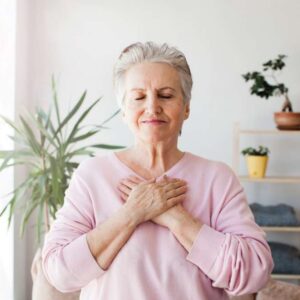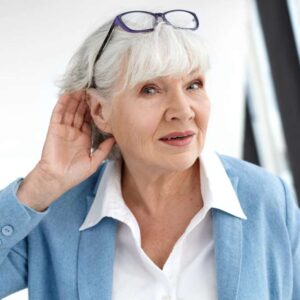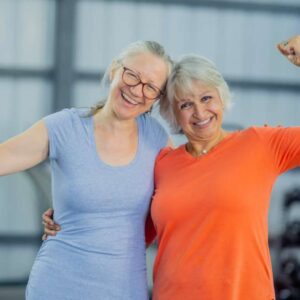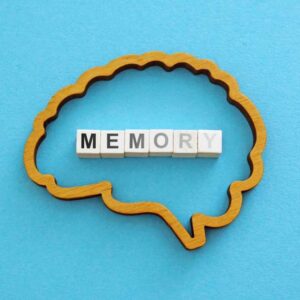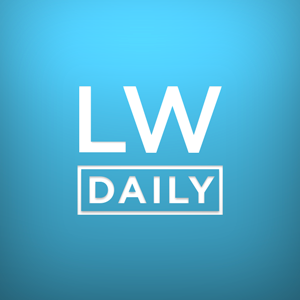
One Easy Way to Get Active No Matter Where You Live
- One community is turning the tables on chronic disease and increasing skills at the same time. Find out how…
- Don’t underestimate the power of the bulletin board
- Get to stepping! Find out an easy way to get on the road to better health.
Dear Reader,
Living a healthy lifestyle in a rural community can sometimes come with extra challenges. Many barriers, such as healthy food access, lack of community physical activity, and isolation, can impede an individual’s health.
Not to say metro areas don’t face their fair share of health challenges, but it seems that rural living can lead to higher incidences of chronic health issues.
In fact, folks who live in some rural communities are often more likely to suffer from chronic diseases like heart disease, diabetes, shorter life expectancy, and obesity.1
However, this doesn’t have to be the case.
In southern West Virginia, one organization has taken a grass-roots approach to increasing community health. And the best part — it seems to be working.
This young organization is known as Active Southern West Virginia, and they are trying to create a healthier community through local exercise groups, increasing conversations about wellness, assisting schools with exercise programs, and delivering healthy living strategies to their community members.
In the first quarter of 2016, they already have over 500 participants — this means they are on track to double the number of participants they had in 2015.
In addition, they have almost doubled their Community Captains, the volunteers who lead activities in their communities, this year — going from 18 to 35.
While out on the road, I had an opportunity to speak with Active Southern West Virginia’s Executive Director, Melanie Seiler, about the origins of the program and its participants, challenges, and future.
Plus, she will share an easy tip with us on how to get active in your community, get exercise, and stay accountable no matter where you live.
Here is what Melanie had to say:
Natalie Moore: Why was Active Southern West Virginia created?
Melanie Seiler: The Economic Development Office of our four counties (Raleigh, Fayette, Summers, and Nicholas) identified part of their strategic plan was going to be community wellness and increasing the health of the workforce so they can attract other industries as we lose the coal industry.
We need big-time manufacturing, anything to move in here with a lot of jobs, and when they go to run the statistics on our workforce, we don’t look very good, compared nationally.
Moore: Why’s that? Is it due to diabetes, heart disease?
Seiler: Yes. It’s chronic disease. It’s disease that’s preventable, and that comes from a lot of factors. Basically, it’s a rural area. There’s a lot of poverty, and there is not access to places to work out — gyms or YMCA facilities.
The main big-picture mission is that we can create more opportunities for physical activity to get the health of the residents back up and focus on physical activity.
We spent this last year recruiting volunteers to be Community Captains leading a weekly program, some type of physical activity that they enjoy doing and can easily get friends, family, co-workers involved in with them once a week: walking, running groups, bicycling, or whatever they want to do.
To do this, we recruit, mentor, and train community captains. Then we provide one-on-one guidance to help develop their program and help them with promotion and communication. Then we send them out to the community in an effort for them to create an opportunity to be physically active in their own small towns.
Plus, they’re also gaining skills and getting leadership experience. So it’s a resume-building component for them and, hopefully, a forward-moving economic step, as well.
So we’re trying to foster up the leaders as well as create an opportunity that’s accessible. And all of it is free. We’re finding that it works really well to offer the Community Captains certifications in exchange for commitments of how long they will continue the program.
Moore: What kind of certification?
Seiler: They start out with first aid and CPR and then go into different certifications that complement where their interests are. For example, one of our community captains is an avid runner and enjoys getting people into running, and she got a running coach certification.
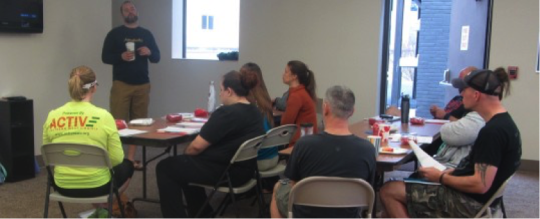
A group of community captains during certification training.
Moore: Very cool. So how do you get the word out about this program and the scheduled activities?
Seiler: We have a flier distribution list, which has become our pot of gold. So at the beginning of the month, we have people — the flier volunteers — who will accept an email with a flier for the county and print out a couple. And they have a bulletin board somewhere that they will put it on.
Moore: So this is kind of a grass-roots movement?
Seiler: Oh, yeah. It is site specific, and because we are dealing with a small population in these communities, if there’s any other factor, event, or function going on — and if maybe you didn’t quite capture the in crowd — then you might miss the whole boat.
Moore: Do you think Active Southern West Virginia is breaking through some of the barriers in these communities?
Seiler: Yes, I think we are. We’re finally getting some recognition, and more people know who we are. When I go to community meetings now versus a year ago — I was always asking “Has anybody heard of us before today?” Now a couple of hands do go up or, “Oh, I saw this on the newspaper,” or, “Oh, I saw this on the news.”
Moore: This region has a varied population as far as media outlets and getting the word out goes. It’s awesome that you guys know how to reach people.
Seiler: I’ll tell you, the bulletin board at the grocery store is as important as Facebook events. The bulletin board at the post office is crucial. And so that distribution flier list is gold.
West Virginians are very passionate people about their community, and especially when you talk about health. They have family around them that are battling all kinds of things, without a whole lot of resources or money to be able to take care of them.
And when the majority of these issues are preventable, they get it. So it’s like we’re really sincerely working on a good mission.
Moore: What do you think your biggest challenge has been?

Active Southern West Virgina participants out enjoying a hike.
Seiler: The biggest challenge is still the communication of getting the message out, and getting it to the right audiences.
But there are also the measurements. We’re excited to get a handle on the evidence-based outcomes because our additional funding is getting turned down for two reasons. One, the big funders will say you’re too new of an organization.
And two, they’ll say where’s the evidence that your program is changing anything in that county? So it’s getting down to taking some physicals. We are partnering with each county’s health department, and they’re more than happy to help. And it’s part of their job to come into a couple of our groups, do measurements every six weeks, and analyze the information.
Moore: Is there a tip you can give our readers for finding community-based activities if they are living in a rural area?
Seiler: Anybody can start a walking group, and it can be a work-based walk at lunch or after work — you meet your group. Social accountability and benefits come from being that walking leader, because you know you’re going to have to stay committed to show up.
And that’s easy. It’s not risky. But getting the 10,000 steps a day and setting up your group that you’re going to meet once a week or twice a week — that’s an easy starting point.
If you live in southern West Virginia area and want more information about Southern Active West Virginia click here.
Live well,

Natalie Moore
Managing editor, Living Well Daily
Ed. Note: Please send your feedback: nmoore@lfb.org – and click here to like us on Facebook.
Sources
[1] Rural Health Disparities, Population Health, and Rural Culture
Written By Natalie Moore
Natalie Moore is a dedicated health researcher with a passion for finding healthy, natural, and science-based solutions. After a decade of direct healthcare experience in western and natural medicine, she was involved in public health research before joining Living Well Daily.
View More Free Articles
Doctor-Approved Method to Ditch Blood Pressure Meds
In a world where drug solutions dominate healthcare, it’s refreshing to discover that best remedies sometimes don’t involve a single pill. A groundbreaking study shows simple relaxation techniques could be your secret weapon against one of America’s deadliest health conditions. Best of all? It’s free, easy to start right away—and your results are bound to...
Trouble Hearing? Your Heart Could Be at Risk
With research exploding and data pouring in, scientists are uncovering some weird (and surprisingly helpful) health connections. Today’s odd couple? Hearing loss and heart failure. Turns out your ears and your ticker are more connected than you ever imagined. A major study published in the journal Heart looked at over 164,000 people for nearly a...
Stay Up Late? It Could Destroy Your Mental Health
If you dread mornings but come alive at night, there’s concerning new research you need to know about. A recent study found that “night owls” are at higher risk for depression. But before you rush to set your alarm to get up with the sun tomorrow, there’s more to the story… Chronotypes are essentially your...
Go from Flabby to Fit with this Common Vitamin
If you’re like many of us, you woke up one day, looked in the mirror, and realized you’re no spring chicken anymore. Even worse—when you weren’t paying attention—it seems you somehow misplaced the muscles of your youth and have gone from fit to flabby. Aging has a way of humbling us like that. But scientists...
Seasonal Allergy “Off Switch” Discovered in the GUT
“Doc, why am I suddenly suffering from seasonal allergies when I’ve never had them before?” It’s a question I get all the time—and my answer might surprise you. Stop looking up at the trees—and start looking down at your gut… Your sneezing fits, itchy eyes, and runny nose might have more to do with what’s...
“Canary in the Coal Mine” Test Sniffs Out Brain Issues Early
One of the most common questions I get is how to tell if you’re starting to experience cognitive decline. I get it—losing your memory is scary, especially when it sneaks up on you. But here’s some exciting news that might put your mind at ease. A fascinating new study suggests that your nose might be...
BEAT Stubborn Leg Swelling Without Dangerous Diuretics
“I need help with edema.” —Swollen Hi Swollen, When patients complain of edema—fluid retention that causes feet, ankles, and legs to swell—I explain that, while conventional medicine immediately prescribes diuretic drugs, nature offers us effective solutions we can try first. I’ll share those in just a moment, but first, let’s take a quick look at...
Mental Health Linked to 30% FASTER Aging [6-Step FIX]
Your mind and body are more connected than you might realize—and a groundbreaking new study proves just how profound that connection really is. In fact, it’s this mind-body link that helps explain why battling depression can put you on the fast track to physical decline. Depression is the most common mental health condition worldwide. We’ve...
The Air You Breathe Is Silently Stealing Your Memory
You already know that air pollution damages your lungs. Chances are you’ve heard it can also harm your heart. And I bet you won’t be surprised when I tell you it claims millions of lives annually. But now, alarming new research suggests polluted air might also damage your brain. This study found that long-term exposure...
Get Intermittent Fasting Benefits Without Going Hungry
Intermittent fasting, which involves cycling between eating and fasting periods, is effective. There’s plenty of evidence for that. It’s not just weight loss, either. Intermittent fasting has significant benefits for metabolic health. However, many people find fasting difficult to stick to—and others can’t do it at all due to medical issues—so they miss out on...
